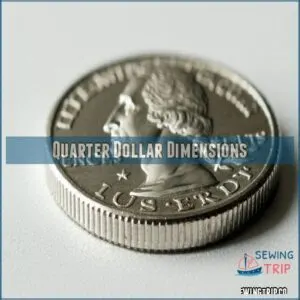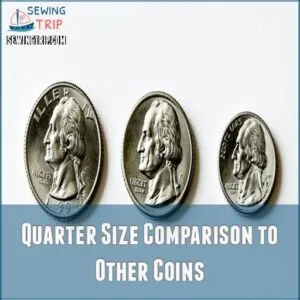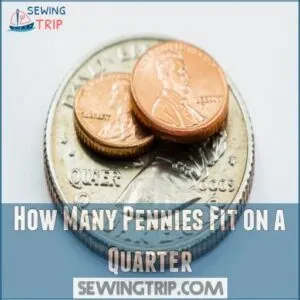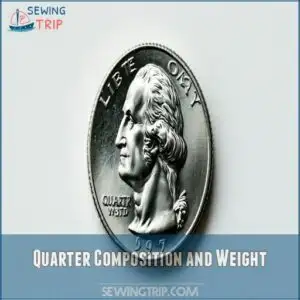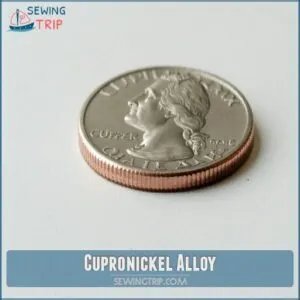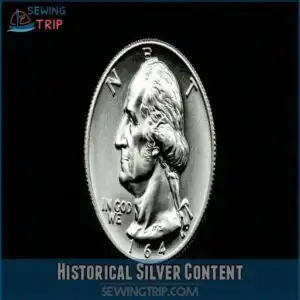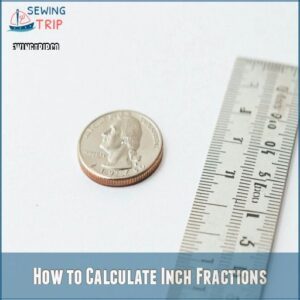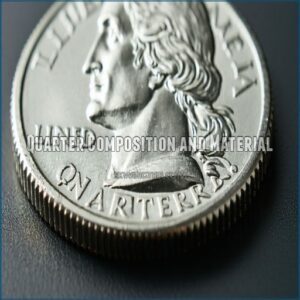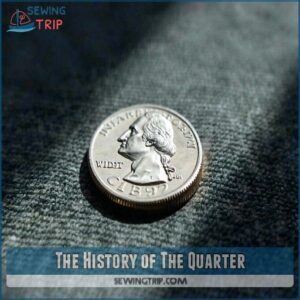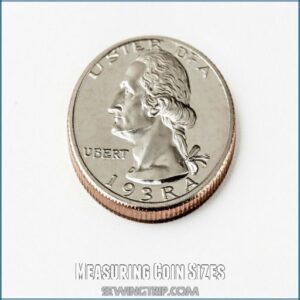This site is supported by our readers. We may earn a commission, at no cost to you, if you purchase through links.
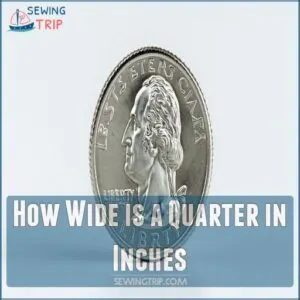
Well, it’s an impressive 0.955 inches across.
This measurement makes it a handy tool for those at-home projects where you need a quick reference.
Imagine stacking coins or checking heights with a trusty quarter; it fits perfectly into tight spots.
Made from a durable cupronickel alloy, this coin might even survive a curious dog’s snack attack!
If you’re comparing, a dime is smaller, while the dollar coin trumps in size.
Ready to learn more about quarters?
There’s more to explore about their surprising versatility and history!
Table Of Contents
- Key Takeaways
- Quarter Dollar Dimensions
- Quarter Width in Inches Answer
- Quarter Coin Specifications
- Quarter Design and Features
- Comparing Coin Sizes
- How to Calculate Inch Fractions
- Quarter Composition and Material
- The History of The Quarter
- Measuring Coin Sizes
- Interesting Facts About Quarters
- Frequently Asked Questions (FAQs)
- Conclusion
Key Takeaways
- You’ll find that a U.S. quarter measures exactly 0.955 inches in diameter, making it a handy tool for quick measurements.
- The quarter is wider than both dimes and nickels but smaller than half-dollar coins, placing it mid-range among common U.S. coins.
- Its composition involves a durable cupronickel alloy with 91.67% copper and 8.33% nickel, ensuring longevity in circulation.
- Quarters feature 119 reeded edges, which not only aid grip but also serve as an anti-counterfeiting measure.
Quarter Dollar Dimensions
You’ll find the exact width of a U.S. quarter is 0.955 inches, making it wider than both dimes and nickels.
The quarter’s precise diameter allows you to use it as a handy measuring tool when you don’t have a ruler nearby.
Diameter in Inches
A quarter’s diameter measures exactly 0.955 inches, making it the perfect size for everyday transactions and vending machines.
You’ll notice it’s wider than a nickel but smaller than a half dollar.
Three ways to visualize a quarter’s width:
- It’s about the width of a standard paper clip when unfolded
- Nearly identical to a #2 pencil’s diameter
- Similar to two dimes placed side by side
Thickness Measurement
A quarter’s thickness is about as slim as a stack of three credit cards, measuring exactly 0.069 inches (1.75 mm), similar to the thin fabric layers involved in preserving original hems when working with jeans.
You’ll find this measurement remains consistent across modern quarters thanks to the U.S. Mint’s strict standards, which allow for tiny variations between 1.70 mm and 1.80 mm.
Pre-1965 silver quarters were slightly thicker due to their different metal composition.
Circumference and Surface Area
The circumference of a quarter follows a perfect circle at 3 inches (76 mm), making it ideal for geometry demonstrations.
For precise quarter-size inch templates, you can find suitable products at quarter size inches tools.
You’ll find its surface area measures precisely 0.72 square inches (463 square millimeters) on each side.
These measurements come from using the standard formula for circular area: π × radius².
For coin collectors, these dimensions help authenticate genuine quarters from counterfeits.
Volume and Weight
Inside a quarter’s compact frame, you’ll find surprising density.
At 5.67 grams, it’s packed into a volume of 0.048 cubic inches (785.07 cubic millimeters).
That’s heavier than both a penny (2.5g) and dime (2.27g) combined!
When you’re holding a quarter, you’re actually gripping a precise blend of copper and nickel that’s carefully engineered for the best possible weight distribution.
Quarter Width in Inches Answer
You’ll find that a U.S. quarter measures exactly 0.955 inches in diameter, making it wider than both dimes and nickels.
This precise measurement lets you use a quarter as a handy size reference when you don’t have a ruler nearby.
How Wide is a Quarter in Inches
Every U.S. quarter measures exactly 0.955 inches in diameter, a precise measurement that’s been consistent since its introduction.
You’ll find this width measurement equals 24.26 millimeters in metric units.
Whether you’re measuring a brand-new quarter or one from decades ago, you’ll get the same result – quarters maintain strict size specifications to guarantee they work reliably in vending machines and coin mechanisms.
Quarter Size Comparison to Other Coins
Comparing quarters to other coins reveals fascinating size differences.
Your quarter’s 0.955-inch diameter makes it noticeably larger than a dime’s 0.705 inches but smaller than a nickel’s 1.35 inches.
When you line them up, you’ll notice quarters sit perfectly between these denominations in size.
For coin collectors and everyday users alike, understanding these relative sizes helps quickly identify coins by sight or touch.
Quarter Size Comparison to Other Objects
Your quarter’s width of 0.955 inches matches everyday items you’ll find around the house.
It’s roughly the same size as a standard paper clip when fully extended, slightly wider than a typical USB port, and about half the width of a credit card’s short edge.
You’ll notice it’s also similar to the diameter of a AA battery’s end cap.
You can also find products like quarter spacers and gauges online at quarter width inches tools.
How Many Pennies Fit on a Quarter
After examining various objects, let’s look at coin stacking potential.
A quarter’s 0.955-inch diameter can accommodate roughly two pennies (0.75 inches each) placed side by side on its surface.
Due to the penny’s smaller diameter, you’ll notice a slight overhang when positioning them.
This coin dimension comparison helps visualize just how precisely the U.S. Mint crafts each denomination’s specifications.
Quarter Coin Specifications
You’ll find that modern quarters contain an exact mix of 91.67% copper and 8.33% nickel, creating a durable coin that weighs 5.67 grams.
If you’re examining a quarter made before 1965, you’re holding a piece of history that contains 90% silver and 10% copper instead.
Quarter Composition and Weight
Modern quarters have specific weight requirements that set them apart from their predecessors.
You’ll find that today’s quarters weigh exactly 5.67 grams (0.2 ounces), making them perfect for vending machines and coin-operated devices.
The weight comes from a precise mix of metals that replaced the earlier silver composition.
Want to know if you’ve got a silver quarter? Pre-1965 quarters weigh slightly more.
Cupronickel Alloy
The cupronickel alloy in quarters combines copper and nickel in a precise 75/25 ratio, creating a durable and corrosion-resistant coin. You’ll find this smart blend offers the perfect balance of strength and cost-effectiveness for everyday use.
- Won’t tarnish like pure silver coins
- Maintains its shine even after decades of circulation
- Withstands extreme temperature changes without warping
- Resists wear from constant handling in commerce
Historical Silver Content
Silver quarters from before 1965 pack quite a different punch than today’s coins.
You’ll notice this difference immediately if you’re lucky enough to find one – they’re 90% pure silver and 10% copper.
Here’s how the composition changed over time:
| Year Range | Silver % | Copper % | Other Metals |
|---|---|---|---|
| Pre-1965 | 90% | 10% | None |
| 1965-1968 | 40% | 60% | None |
| 1969-1970 | 40% | 60% | None |
| 1971-Now | 0% | 75% | 25% Nickel |
Total Weight of a Quarter
While earlier quarters contained pure silver, today’s coins weigh exactly 5.67 grams (0.2 ounces) and are a standard quarter size, often used in products found at stores like those on quarter size products.
You’ll notice modern quarters feel slightly lighter than their pre-1965 counterparts.
This precise weight helps vending machines and coin counters accurately identify genuine quarters.
For comparison, that’s about the same as five paper clips or two pennies – making quarters a perfectly balanced piece of pocket change.
Quarter Design and Features
You’ll notice the quarter’s iconic design features George Washington’s profile on the front and various American scenes on the back, each carefully crafted to prevent counterfeiting.
The quarter’s distinct reeded edge contains exactly 119 ridges, making it easier to grip and serving as an important security feature that dates back to when coins contained precious metals.
George Washington’s Profile
From a powdered wig to a ponytail, you’ve seen George Washington’s portrait countless times on the quarter – but there’s more to this iconic design than meets the eye.
Created in 1932 by sculptor John Flanagan, the portrait shows Washington facing left, capturing his strength and dignity.
You’ll notice fine details in his hair, strong jawline, and determined expression that have made this design timeless.
Evolution of Reverse Imagery
Many fascinating changes have graced the reverse side of quarters since their 1932 debut.
You’ll spot the iconic eagle design that lasted until 1998, when the State Quarters Program kicked off a revolution in coin artistry.
Now you’ll find everything from national parks to historical figures, with each design telling a unique American story.
The America the Beautiful series (2010-2021) showcased natural wonders across the nation.
The Reeded Edge Feature
Take a close look at the edge of your quarter, and you’ll spot those distinctive parallel lines running around the rim.
These grooves, known as reeding, feature 119 ridges precisely cut into the coin’s surface.
Each ridge is carefully crafted during the minting process using special collar dies that imprint the pattern simultaneously with the coin’s faces.
The reeded edge has remained largely unchanged since 1796.
Purpose of Reeding
Those ridges along a quarter’s edge aren’t just for show.
Reeding serves as a built-in security feature that’s been around since the 1700s, making counterfeiting much harder.
You’ll notice these grooves help you grip the coin better too.
Back when quarters contained silver, reeding prevented people from shaving off precious metal – a sneaky practice called "clipping" that’s now part of coin history.
Comparing Coin Sizes
You’ll notice major size differences when you line up a quarter next to other U.S. coins, from the tiny dime at 0.705 inches to the hefty half dollar at 1.205 inches.
With its 0.955-inch diameter, the quarter sits right in the middle of the U.S. coin size range, making it a perfect reference point for comparing other coin sizes.
Quarter Vs. Dime and Nickel
When you place a quarter next to other common coins, you’ll notice significant size differences. A quarter’s 0.955-inch diameter makes it distinctly larger than both dimes and nickels.
- A quarter is 35% wider than a dime (0.705 inches)
- Nickels measure 0.835 inches across
- You could fit 2.5 dimes across a quarter’s face
Pre-1965 quarters were slightly thicker
Modern quarters maintain strict size tolerances of 0.00316 inches
Quarter Vs. Half Dollar and Dollar
Every U.S. quarter looks tiny next to the hefty half dollar and dollar coins.
You’ll notice the half dollar measures 1.205 inches across – that’s about 25% wider than a quarter’s 0.955 inches.
Dollar coins are even more substantial at 1.043 inches in diameter.
Here’s a fun fact: you could stack about 14 quarters to match the weight of just one half dollar.
Quarter Size Comparison to Penny
A quarter’s 0.955-inch diameter dwarfs a penny’s 0.75-inch width, making it about 27% larger.
You can easily test this by placing two pennies side by side on top of a quarter – they’ll fit with a bit of space to spare.
The quarter’s larger surface area makes it ideal for coin-stacking games, though its thinner profile (1.75mm vs penny’s 1.52mm) gives it a distinctly different feel.
How to Calculate Inch Fractions
You’ll find it easy to switch between decimals and fractions once you understand the simple math behind inch measurements.
Whether you’re working with quarters or other coins, converting between these number formats helps you make precise measurements without getting stuck.
How to Convert Inches to Fraction
Converting inches to fractions doesn’t have to be a headache.
You’ll master this essential skill with these simple steps: First, understanding how to sew a buttonhole using a buttonhole foot technique can be super helpful
- Start by identifying the decimal portion (like.955 in a quarter’s width)
- Multiply that decimal by the desired fraction denominator (usually 16 or 32)
- Round to the nearest whole number and simplify the fraction
Think of it like slicing a pizza – you’re just breaking down one whole into smaller, equal pieces.
Decimal to Inches Chart
A decimal-to-inches chart makes quick work of those tricky measurements.
You’ll find common fractions like 1/4 inch equals 0.250 inches, while 3/8 inch converts to 0.375 inches.
The chart breaks down measurements from 1/64 inch (0.015625) up to 1 inch (1.000), making it simple to match your decimal readings to standard inch fractions used in everyday projects.
Inches to Decimal Chart
The inches to decimal chart streamlines your fraction calculations, making them a breeze to reference.
Here’s what you’ll spot on a typical chart:
- Common fractions lined up with their decimal equivalents (1/2 = 0.500)
- Fractional increments from 1/64 to 63/64
- Decimal values rounded to three places for precision
- Metric conversions for each fraction in millimeters
Keep this chart handy – it’s your go-to reference for quick conversions without the mental math.
How to Find Inch Fractions on a Tape Measure
Reading inch fractions on a tape measure is simpler than you’d think.
Look for the longest marks – those are quarter inches (¼, ½, ¾).
Medium-length marks show eighth-inch increments (⅛, ⅜, ⅝).
The smallest marks? Those are sixteenth-inch measurements (1/16, 3/16, 5/16).
When you need more precision than 1/64 of an inch, switch to digital calipers for ultra-accurate readings.
Quarter Composition and Material
You’ll find modern quarters contain a precise mix of 91.67% copper and 8.33% nickel, creating a durable silver-colored metal called cupronickel.
If you’re holding a quarter made before 1965, you’ve got a different mix in your hands: 90% silver and 10% copper.
What Are Quarters Made Of
Modern quarters pack quite a punch in terms of their composition, featuring a precise blend of metals that’s stood the test of time. Here’s what makes up these pocket-sized powerhouses:
- Pre-1965 quarters contained 90% silver and 10% copper
- During World War II, metal composition remained unchanged
- The San Francisco Mint produced special silver proof quarters
- Silver quarters are still highly sought after by collectors today
Learn more about your quarter’s exact copper-nickel ratio in the next section!
75% Copper and 25% Nickel
You’ll find today’s quarters pack quite a metal mix – precisely 75% copper and 25% nickel.
This combination isn’t random – copper provides durability while nickel adds that distinctive silver shine you’re familiar with.
When you’re holding a quarter, you’ve got about 5.2 grams of copper and 0.47 grams of nickel in your hand.
Pretty neat for a coin that costs just 25 cents!
Historical Composition of Quarters
Before 1965, quarters had a completely different makeup than today’s coins. Notably, just as nylon fibers are more prone to moisture absorption compared to polyester fibers, which absorb only 0.4% water like in moisture-wicking sportswear, the U.S. Mint had to adapt to changing material needs.
Looking back through U.S. Mint records reveals fascinating changes in quarter composition:
- Pre-1965 quarters contained 90% pure silver and 10% copper
- The silver crisis of 1964 forced a composition change
- 1965-present quarters use the current copper-nickel blend
- Silver quarters from before 1965 are worth more than face value
This dramatic shift from silver to copper-nickel marked a defining moment in U.S. coinage history.
How Quarters Are Made
The U.S. Mint transforms metal sheets into quarters through a fascinating process.
First, they punch out coin blanks, which look like metal discs.
These blanks get heated and softened before machines stamp them with George Washington’s profile and the reverse design.
Each quarter then goes through rigorous quality checks to make sure it has perfect dimensions, weight, and detail before heading to banks nationwide.
The History of The Quarter
You’ll find that quarters have been part of American currency since 1796 when they were first minted at the Philadelphia Mint.
Since then, they’ve changed from pure silver to today’s copper-nickel mix, but they’ve kept the same width of 0.955 inches that you use today.
When Was The Quarter Introduced
Since its birth in 1796, the quarter has been a cornerstone of American commerce.
You’ve probably handled thousands of these coins, but did you know they were first struck at the Philadelphia Mint using hand-operated screw presses?
Around the same time, inventors were revolutionizing manufacturing with new innovations, such as the sewing machine invention.
Originally crafted from pure silver, these early quarters featured Lady Liberty on the front – a design that would grace our quarters for over 130 years.
Evolution of Quarter Design
Looking closely at old quarters reveals America’s journey through time.
After its 1796 debut featuring Lady Liberty, you’ll notice that quarter designs shifted with the nation’s changing tastes.
Different artists brought their vision to Lady Liberty’s portrait until 1932, when George Washington’s profile became the standard face.
Each version, from the Liberty head to the Barber coin, tells a unique story of its era.
Significant Changes to Quarter Design
Changes to quarter designs mark significant moments in American history.
You’ll notice three major transformations that shaped this iconic coin:
- 1932: Washington’s portrait replaced Lady Liberty, commemorating his 200th birthday
- 1999: State quarters program kicked off, featuring unique reverse designs for all 50 states
- 2022: American Women quarters program launched, celebrating influential female figures
Each change tells a story about America’s evolving identity.
Quarter Minting Process
Through a fascinating process spanning five stages, quarters come to life at U.S. Mint facilities.
You’ll find the journey from raw metal to pocket change quite remarkable.
| Stage | Process | Quality Control |
|---|---|---|
| 1 | Metal strip preparation | Alloy composition check |
| 2 | Blank punching | Size verification |
| 3 | Edge rimming | Surface inspection |
| 4 | Design striking | Detail examination |
| 5 | Final inspection | Weight confirmation |
Each quarter must meet strict specifications before making its way to your wallet.
Measuring Coin Sizes
You’ll need the right tools to measure a quarter’s exact dimensions, including a digital caliper for precise diameter readings and a micrometer for thickness.
Knowing how to properly measure coins will guarantee you’ll get accurate results every time.
Whether you’re a coin collector or just curious about U.S. currency measurements, knowing how to properly measure coins will guarantee you’ll get accurate results every time.
How to Measure Coin Diameter
A coin’s diameter measurement requires precision and the right tools to get it spot-on.
You’ll get the most accurate results with these essential tools:
- Digital calipers: These give you readings down to 0.001 inches
- Metric ruler: Perfect for quick measurements, though less precise
- Coin measuring gauge: A specialized tool that collectors swear by
For quarters specifically, place the coin flat and measure across its widest point for the most accurate reading.
How to Measure Coin Thickness
After mastering diameter measurements, you’ll want accurate thickness readings of your coins.
A digital caliper gives you the most precise measurements, while a manual caliper offers reliability without batteries.
Here’s a comparison of common measuring tools:
| Tool Type | Accuracy (mm) | Best For |
|---|---|---|
| Digital Caliper | ±0.01 | Professional collectors |
| Manual Caliper | ±0.02 | Daily use |
| Thickness Gauge | ±0.05 | Quick checks |
| Micrometer | ±0.001 | Lab-grade precision |
| Coin Card | ±0.1 | Portable solution |
How to Measure Coin Weight
Measuring coin weight demands precision and the right technique, much like taking accurate body measurements with a flexible measuring tape requires consideration of posture and undergarments for a proper fit learn how to take measurements for sewing.
You’ll want to calibrate your scale on a level surface, away from drafts or vibrations that could affect readings.
For bulk counting, group coins by denomination – each quarter weighs exactly 5.67 grams, nickels are 5 grams, and modern pennies hit 2.5 grams.
Just multiply your total weight by the coin’s standard weight.
Tools for Measuring Coin Sizes
You’ll need precise tools to get accurate coin measurements.
A digital caliper gives you the most precise diameter readings, while a micrometer excels at measuring thickness.
For quick checks, a quality ruler or measuring tape works well.
Digital scales accurately weigh coins to the nearest 0.1 gram.
Remember, professional-grade tools are worth the investment if you’re serious about coin collecting.
Interesting Facts About Quarters
When you think of quarters, you mightn’t realize the precise standards required to produce them.
From unique features to their strict production process, there’s more to quarters than meets the eye.
Unique Features of Quarters
Spotting unique features of quarters lets you appreciate their charm beyond pocket change.
From reeded edges that deter counterfeiting to state quarter designs showcasing regional pride, there’s a story etched onto each.
Commemorative quarters capture history, while quarter errors intrigue collectors.
So, next time you jingle a few coins, take a second to admire their subtle artistry and heritage.
Quarter Production Process
In the quarter production process, quality control is key.
It starts with blank production—creating precise metal discs.
The minting process involves placing these blanks between dies, which hold the coin design.
Die creation is vital for detail and durability.
This careful process guarantees each quarter emerges with sharp features, ready for circulation while meeting rigorous standards.
Quarter Collectibility
Explore the fascinating world of quarter collectibility!
A coin’s charm often lies in its design—think Proof quarters or State quarters that capture iconic landmarks.
Commemorative quarters mark historic events while different quarter grades determine a coin’s worth.
For collectors, each piece is more than metal—it’s a slice of history that resonates through time, inviting enthusiasts to explore their narratives.
Quarter Error Coins
Ever stumble upon a weirdly shaped quarter?
Those are quarter errors, my friend!
Coin varieties like these are a big deal for collectors.
Collectors guides detail value variations.
Rare quarters fetch big bucks.
Some errors are minor, others major.
It’s a fascinating hobby, unearthing these hidden treasures.
You might even have a valuable quarter in your pocket right now!
Check your change – you never know!
Frequently Asked Questions (FAQs)
What is the diameter of a quarter coin?
Imagine measuring the moon in inches—the diameter of a quarter coin is precisely 955 inches.
Keep that tidbit handy next time you’re contemplating the universe or just need the right fit for a gumball machine.
How big is a quarter in inches?
A quarter’s diameter is 955 inches, making it just shy of an inch wide.
Whether you’re stacking them for a wish or calculating value, knowing its size helps you manage coins more effectively.
How thick is a quarter?
Isn’t it interesting how small details often go unnoticed until asked?
A U.S. quarter is 069 inches thick.
This precise measurement guarantees reliability every time you use it, reflecting careful standards set by the U.S. Mint.
How big should a quarter be?
A quarter should be about 955 inches in diameter, weighing 67 grams.
Its size makes it ideal for day-to-day transactions and easy recognition among U.S. coins.
Its precise dimensions guarantee uniformity across millions minted annually.
How big is a quarter dollar?
A quarter’s a small silver circle, right? It’s about an inch across, precisely 955 inches in diameter. That’s a little less than an inch. Handy to know!
How much does a quarter weigh?
A quarter weighs 67 grams, just the right heft to feel substantial without weighing down your pocket. This weight comes from its cupro-nickel composition, which is 67% copper and 33% nickel.
Is a quarter 1 inch across?
Think of a quarter as almost the size of a small cookie cutter—it measures 955 inches across.
So, it’s just shy of a full inch,
not quite making the cut for a 1-inch diameter.
How wide is a quarter?
A quarter measures 955 inches across, making it slightly less than an inch in diameter.
This size makes it both recognizable and easy to handle, fitting nicely between a dime and a nickel in width.
What size is a quarter in inches?
Don’t worry about needing complex tools to find this out: a quarter is 955 inches in diameter.
That’s just under an inch, making it perfect for quick comparisons or quick measurements without digging through your toolbox.
Is.25 a quarter inch?
Yes, .25 is a quarter inch.
It’s one-fourth of an inch, dividing the inch into four equal parts.
When you see a measurement like.25 inches, you can think of it as a quarter-inch.
Why do quarters have ridged edges?
Quarters have ridged edges, known as reeded edges, to prevent counterfeiting and to thwart coin clipping—a practice where people shaved off small amounts of precious metal from the edges of the coins for profit.
What is the most valuable quarter?
Determining a quarter’s value isn’t simple!
Its worth depends on its condition, year, and any unique features.
Some rare quarters fetch thousands; others, just 25 cents.
So, you’ll need to do some research!
How often are quarters redesigned?
You’re curious about quarter redesigns?
They get a fresh look every few years, thanks to programs like the U.S. State Quarters and America the Beautiful series.
These initiatives keep the designs vibrant and collectors engaged.
Are there quarters made outside the U.S.?
Ever wondered if quarters are minted outside America?
Most U.S. quarters are produced domestically.
But some nations use similar coin designs for local currency or collectibles.
Collectors might find foreign imitations, but authentic U.S. quarters are homegrown.
Do quarters have collectible value today?
Quarters can be highly collectible, especially valuable ones like 50 State Quarters or limited releases.
Condition, rarity, and historical significance drive their value.
They’re worth looking into if you’re interested in coin collecting or investing.
Conclusion
With everything you’ve learned, the realm of coins is as clear as day.
The quarter, with its width of 0.955 inches, serves as a fascinating piece of history and a handy tool.
Whether you’re comparing it to other coins or stacking them up for fun, a quarter’s specifics cover diameter, materials, and more.
So next time you pull one from your pocket, remember its versatile size and the rich history it carries!

